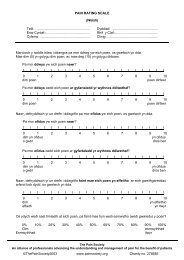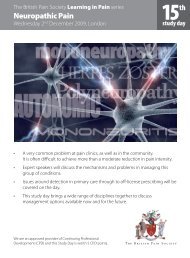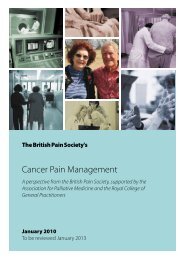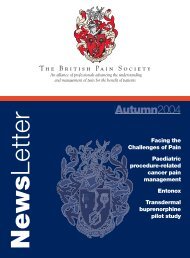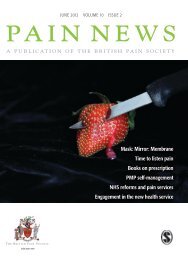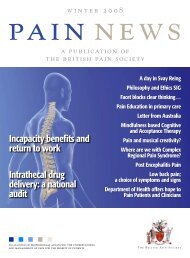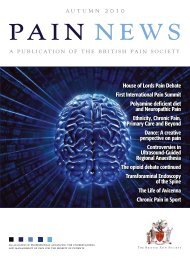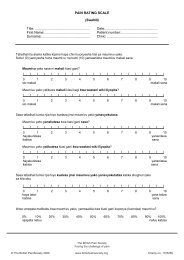Summer 2010 - The British Pain Society
Summer 2010 - The British Pain Society
Summer 2010 - The British Pain Society
You also want an ePaper? Increase the reach of your titles
YUMPU automatically turns print PDFs into web optimized ePapers that Google loves.
CHANGING PRACTICE<br />
Does Vitamin C have a<br />
role in the prevention of<br />
Complex Regional <strong>Pain</strong><br />
Syndrome?<br />
Dr Michael J.E. Neil<br />
Ninewells Hospital Dundee<br />
mneil@nhs.net<br />
Complex regional pain syndrome<br />
(CRPS) is an important and<br />
commonly encountered neuropathic<br />
condition in the pain clinic. CRPS<br />
has a significant associated morbidity<br />
and is characterised by spontaneous<br />
pain, hypersensitivity, sudomotor<br />
dysfunction and functional loss. It<br />
can be triggered by potentially any<br />
stimulus but is most frequently seen<br />
following fracture, dislocation or<br />
surgery.<br />
<strong>The</strong> pathophysiology of CRPS is<br />
complex and no one intervention<br />
has been shown to have consistent<br />
and reliable efficacy in its<br />
management. In this regard, there<br />
has been a lot of work undertaken in<br />
recent years aimed at preventing the<br />
syndrome developing. Studies have<br />
examined many different therapies<br />
but unfortunately most have<br />
involved only small patient numbers<br />
with largely inconclusive results.<br />
However, there is some good quality<br />
evidence to suggest that vitamin C<br />
may have a significant role to play<br />
in attenuating the development of<br />
CRPS.<br />
Vitamin C is a simple water<br />
soluble sugar-like molecule that is<br />
an essential dietary component.<br />
Humans are unable to synthesise<br />
vitamin C due to a deficiency<br />
in the enzyme L-gulonolactone<br />
oxidase required in the last stage<br />
of its synthesis. <strong>The</strong> recommended<br />
adult daily intake of vitamin C is<br />
75-90mg per day 1 and is relatively<br />
easily achieved as vitamin C is<br />
found in plentiful supply in fruit and<br />
vegetables. Historically however,<br />
deficiency of vitamin C, popularly<br />
known as scurvy, carried a significant<br />
mortality on long sea-faring voyages<br />
and even during land based<br />
conflicts as recently as world war<br />
one. Clinical characteristics include<br />
fatigue, myalgia and arthralgia<br />
in minor deficiency progressing<br />
to neuropathy, haemorrhage<br />
and convulsions in severe cases.<br />
Although it is rare to see frank<br />
vitamin C deficiency in modern<br />
practice, some evidence suggests<br />
that up to 30% of the population in<br />
North America may have sub-clinical<br />
deficiency 1 .<br />
Vitamin C is involved in a number of<br />
important physiological processes.<br />
Vitamin C is well known as an antioxidant<br />
that aids in the elimination<br />
of reactive oxygen species such<br />
as hydroxyl ions. This is important<br />
for the protection of capillary<br />
endothelium and in decreasing<br />
vascular permeability. Victims of<br />
polytrauma and severe sepsis,<br />
conditions that exert a very high<br />
oxidative stress on the body, have<br />
been found to have extremely low<br />
or absent levels of vitamin C in their<br />
plasma at an early stage following<br />
their injury 2 . Vitamin C is also a<br />
co-factor in at least eight different<br />
enzyme processes including collagen<br />
hydroxylation, norepinephrine<br />
synthesis, tyrosine metabolism and<br />
amidation of peptide hormones.<br />
Furthermore, animal studies indicate<br />
that vitamin C may have an effect on<br />
the glutaminergic system, of which<br />
the NMDA receptor plays a key role,<br />
leading to an anti-nociceptive effect 3 .<br />
<strong>The</strong> pathophysiology of CRPS<br />
involves a number of components<br />
including a neuroendocrine,<br />
inflammatory and sympathetic<br />
response. Increased free radical<br />
expression has been found to be a<br />
feature of CRPS and is associated<br />
with altered micro-angiopathic<br />
circulation and lipid membrane<br />
oxidation 4 . With other studies<br />
demonstrating the utility of vitamin<br />
C in decreasing membrane<br />
permeability and scavenging of<br />
free radicals 5 , there does therefore<br />
appear to be a rationale for its use in<br />
this condition.<br />
Evaluation of therapeutic<br />
interventions in pain medicine are<br />
often hampered by a paucity of<br />
good quality evidence from clinical<br />
studies. Vitamin C is a rare exception<br />
to this in that there have been three<br />
good quality randomised controlled<br />
trials examining the use of Vitamin<br />
C in the prevention of CRPS 6,7,8 .<br />
<strong>The</strong> first of these was published by<br />
Zollinger et al in 1999 with a second<br />
study by the same group in 2007.<br />
This later study was a double blind<br />
randomised-controlled, multi-centre<br />
study looking at the incidence of<br />
CRPS in patients following wrist<br />
fracture. Patients were randomised<br />
to receive a placebo or 200, 500 or<br />
1500mg of vitamin C starting from<br />
the day of fracture for 50 days. 427<br />
patients were enrolled in the study<br />
with a total of 317 randomised to<br />
receive vitamin C and 99 to receive<br />
placebo.<br />
<strong>The</strong> results of the trial were clinically<br />
and statistically significant. Using<br />
the International Association for<br />
the study of <strong>Pain</strong> (IASP) criteria for<br />
establishing the presence of CRPS,<br />
they found a total incidence of CRPS<br />
in the vitamin C group of 2.4% (8<br />
of 317 patients) and 10.1% (10 of 99<br />
patients) in the placebo group (p<br />
value 0.002). Examining differences<br />
between the vitamin C treatment<br />
groups revealed a prevalence of<br />
CRPS of 4.2% in the 200mg group<br />
and 1.8% and 1.7% in the 500mg<br />
and 1500mg group respectively. This<br />
gave a number needed to treat of 12<br />
for the 500mg dose of Vitamin C.<br />
<strong>The</strong> most recent study to examine<br />
the role of vitamin C in preventing<br />
CRPS was conducted by Besse et al<br />
and looked at patients undergoing<br />
elective foot and ankle surgery.<br />
This study involved 392 patients<br />
divided between two groups. <strong>The</strong><br />
first enrolled 177 patients having<br />
elective foot or ankle surgery over<br />
a one-year period and were given<br />
standard treatment. <strong>The</strong> second<br />
group were enrolled the following<br />
year and consisted of 215 patients<br />
given 1g of vitamin C from the<br />
first post-operative day for 45<br />
days. Results were again significant<br />
revealing that patients in Group 1<br />
had a prevalence of CRPS of 9.6%<br />
(18 patients) while those in Group<br />
2 showed a prevalence of 1.7% (4<br />
cases) with a p value of 0.0001.<br />
Although the results of these studies<br />
are persuasive there are a number<br />
of potential sources of error. Firstly,<br />
criticism of the later study could<br />
be directed at the fact that follow<br />
up was by case note review and<br />
not clinical examination. This raises<br />
questions of sensitivity of screening<br />
to pick up CRPS and does not<br />
include information on pain scoring<br />
and sensory testing that would<br />
have been helpful. <strong>The</strong> latter study<br />
also did not consider peri-operative<br />
anaesthetic management to identify<br />
if, for example, a regional technique<br />
5 4<br />
PAI N N E W S S U M M E R <strong>2010</strong>




